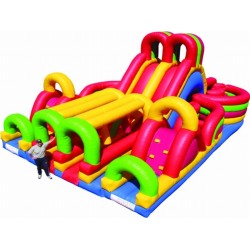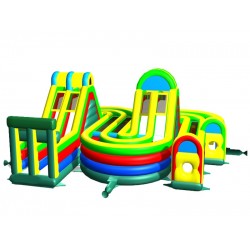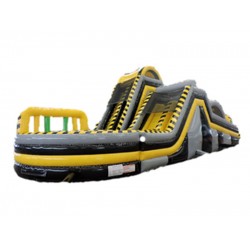Everything You Need to Know About Inflatable Obstacle Courses
29 Jul


Inflatable obstacle courses are large, air-filled structures designed to provide fun and physical challenges for participants of all ages. These courses are typically made from durable, puncture-resistant materials like PVC or vinyl and are inflated using air blowers. They come in various sizes and designs, featuring a range of obstacles and activities.
Components of an Inflatable Obstacle Course
- Slides: Inflatable slides of varying heights and angles provide a thrilling component to the course.
- Climbing Walls: Sections where participants climb using handholds and footholds, adding a physical challenge.
- Tunnels: Inflatable tunnels that participants must crawl or slide through.
- Barriers: Inflatable barriers that participants must navigate around or over.
- Bounce Areas: Sections designed for jumping and bouncing, adding extra fun.
Benefits of Inflatable Obstacle Courses
- Physical Activity: Provides a fun way for participants to engage in physical exercise, improving fitness and coordination.
- Entertainment: Offers a source of entertainment for events, parties, and gatherings.
- Versatility: Suitable for a wide range of ages and events, from children's parties to corporate team-building activities.
- Safety: Designed with safety in mind, with soft, inflatable surfaces that minimize the risk of injury.
Applications of Inflatable Obstacle Courses
- Birthday Parties: A popular attraction for children's birthday parties, providing hours of entertainment.
- School Events: Used for school carnivals, field days, and other school-related activities.
- Corporate Events: Employed for team-building exercises and company picnics.
- Community Festivals: Featured at fairs, festivals, and community gatherings.
Tips for Setting Up and Using Inflatable Obstacle Courses
- Location: Choose a flat, open area free from sharp objects and debris.
- Anchoring: Secure the obstacle course with stakes or sandbags to prevent it from moving.
- Supervision: Always have adults or trained staff supervise the course, especially when children are using it.
- Safety Rules: Establish and enforce rules for safe play, such as no roughhousing and ensuring participants remove shoes and sharp objects.
- Maintenance: Regularly check the obstacle course for any damage or wear and repair as necessary to ensure safety.
Choosing the Right Inflatable Obstacle Course
- Size and Design: Consider the age group and number of participants to select an appropriately sized and designed course.
- Quality: Look for courses made from high-quality, durable materials with strong seams and reinforcements.
- Reviews and Recommendations: Research reviews and seek recommendations to find reliable and reputable suppliers or rental companies.
- Cost: Compare prices and rental fees, but prioritize quality and safety over cost savings.
Inflatable obstacle courses offer a fun and engaging way to add excitement to any event. With proper setup, supervision, and maintenance, they can provide a safe and enjoyable experience for participants of all ages.



